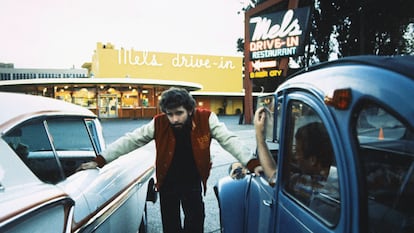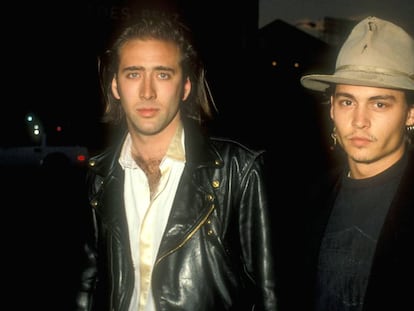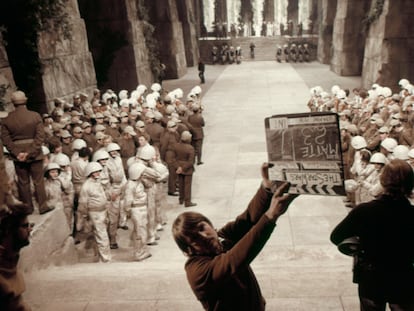Fires, alcohol and an out-of-control Harrison Ford: 50 years later, the making of ‘American Graffiti’ has not been forgotten
Half a century ago, with unknown actors and a tight budget, a young George Lucas took on a weird film that almost ended his career

Before creating one of the most mythical audiovisual franchises in history and eventually turning to the dark side of the Force (selling Star Wars to Disney,) George Lucas had already taken the world by storm with the nostalgic comedy, American Graffiti. Today he remembers it as his first attempt at “human-friendly” filmmaking, after the (otherwise brilliant) act of icy narcissism that had been his first feature,TXH 1138 (1971), a dystopian sci-fi inspired by Godard’s Alphaville, Fritz Lang and other luminaries of European modernism.
Released 50 years ago, American Graffiti cost just $770,000 and grossed over $55 million. Another $63 million was added to that when it was re-released in 1978, coinciding with its fifth anniversary and the overwhelming success of Star Wars (1977). As Lucas’s biographer John Baxter explains, that first assault on cinematic opulence began to take shape after the failure of THX 1138. The movie had gone to Cannes but received rather lukewarm reviews and then went unnoticed at the box office.
According to Baxter, Lucas, then 26 and already accustomed to being considered one of the most promising filmmakers of his generation, took the setback, with “self-indulgent arrogance:” the fault lay with audiences, who had failed to live up to the film. His young wife, Marcia Griffin, an editor and fellow graduate student at the University of Southern California (USC) tried to talk him out of his mistake: it was the film, too strange and arid, that had failed to live up to the audience’s expectations.
Francis Ford Coppola, Lucas’s business partner and close friend, shared Griffin’s verdict. Concerned about his partner’s creative block while he was licking his wounds, Coppola recommended that he make a “human” film next, not another vacuous experiment for intellectuals: “Everyone thinks you’re kind of an amoeba,” Coppola told him, “but I know that if you put your mind to it you can be a very nice, warm guy. I want to see that in your cinema. That’s what you need if you want to make it big in the business.”

While Coppola was breaking new ground with The Godfather (1972), Lucas was working on a vaguely autobiographical project, chronicling the end of his adolescence in Modesto, California around 1962 and at the peak of the rock and roll youth subculture. It was to be the “accessible and empathetic” film that Marcia and Francis were asking for. What’s more, Lucas had set out to show them that he could make a film that was suitable for all tastes, “with my eyes closed.”
It was not so easy. While promoting TXH 1138, Lucas worked on a first draft and then left the script in the hands of his two head writers, Gloria Katz and Willard Huyck, who worked on it for several weeks until they received an offer to direct their own film (Messiah of Evil, which would eventually be released in 1973). Lucas then enlisted the services of another studio partner, Richard Walter, and got Universal Pictures to offer them a $10,000 advance to complete the script.
When he returned from Cannes in the spring of 1971, he found that Walter had made remarkable progress, but in a completely unexpected direction. He had transformed the intended script into the story of a group of kids forming a rock and roll band on the East Coast in the late 1950s. After an unsuccessful attempt to reconcile the two ideas, Lucas fired Walter, but not before handing him the meager $10,000 he had. He locked himself at home and in three weeks completed a script not far from the one that would end up being filmed.
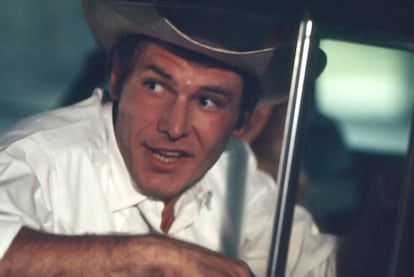
However, doing the rounds of his studio contacts in late 1971 proved to Lucas that producing the film was not going to be easy. Although he had seed money, managed by his father, Lucas was refused financing by Paramount, Columbia Pictures, Warner Bros., 20th Century Fox and Metro Goldwyn Mayer, who were all reluctant to trust a young filmmaker with a reputation as an “auteur” and a disappointing first film on his résumé. American International Pictures, B-movie king Roger Corman’s production company, even considered offering a modest sum, less than half a million dollars in any case, on the condition that Lucas would introduce a certain amount of sex and violence into the script — a proposal that was rejected. Even Coppola was unwilling to invest in the project, disheartened by the dire economic situation of his own company, American Zoetrope (conceived as a large incubator studio that had set out to compete with the Hollywood majors, but which was then losing money hand over fist).
In the end, Lucas and his producer, Gary Kurtz, managed to reach a somewhat fragile deal, full of conditional clauses, with Universal. The main stumbling block was that Lucas had structured his script around 75 rock and roll hits from the early 1960s, including several Elvis classics, so the rights alone to reproduce those tracks would have cost a fortune before filming had even started. In an exercise of realism that he would have been incapable of months earlier, Lucas made substantial concessions. He gave up Elvis and agreed that the planned 75 songs would become only 40. He also agreed to shoot the film in six weeks and for a maximum of $600,000, an amount he increased to $775,000 as soon as Coppola came to his aid and became executive producer. Baxter explains that Universal’s management abhorred the script, distrusted Lucas, and didn’t have much faith in nostalgic comedies of manners but were seduced by the chance to hang the phrase: “The new project from the director of The Godfather” on one of its posters.
The film was shot between July and August 1973 in a town called Petaluma, with a population of 1,500 in the San Francisco area, and which is now a destination for film tourists. The shoot turned out to be chaotic but ultimately successful. It is the stuff of legend from that exceptional period of the new Hollywood, in which, as George Lucas himself explained, “the studios momentarily lost control and we lunatics snatched the keys to the asylum.”
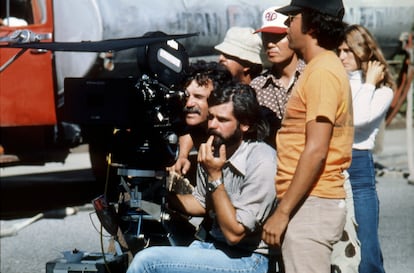
Strictly speaking, it could almost be said that nothing exceptional occurred. The film was completed on schedule and within budget. However, as Eric D. Snider, editor of Mental Floss says, “several of those involved, starting with Lucas himself and one of his lead performers, Richard Dreyfuss, were nearly killed in the summer of 1972″ in a series of bizarre incidents attributable to the “inexperience, irresponsibility, youth, and delusional lifestyle” of many of those involved in this slapdash epic.
For starters, the hotel room where Lucas stayed during his Pentaluma days burned down in the small hours of the morning a few days before filming ended. It was set on fire by a supporting actor whose identity has still not been disclosed. Eyewitnesses Harrison Ford and Ron Howard can attest that the blaze happened and could have ended in tragedy, but no one is quite sure if the cause was a prank gone wrong, a major blunder, or retaliation against (in Howard’s opinion) the young Lucas’s “passive but expeditious” way of directing.
As for Dreyfuss, a fellow actor, Paul Le Mat, gave him a nasty gash on his forehead by throwing him into a swimming pool. Ron Howard, who at the time had just turned 18 and was trying to leave behind his past as a child actor on The Andy Griffith Show, was bombarded with beer bottles by Le Mat, Ford, and company who were upset that he refused to share a few drinks with them. Howard’s parents then threatened to sue the producers for not defending the boy from harassment by his colleagues. Mackenzie Philips, then 12 years old, got her parents’ permission to participate in the filming on the condition that Gary Kurtz would act as guardian. Kurtz was on the verge of sending her home, worried that such a young girl would be surrounded by such a chaotic shoot, with twenty-somethings shooting their scenes in the wee hours of the morning and spending the rest of the day drinking like crazy, climbing up on the sign for the Holiday Inn where they were all staying, or getting into fights in the local bars. To top it off, several members of the technical team were arrested for growing marijuana.
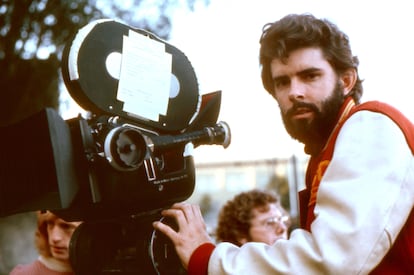
In the words of Dreyfuss and Le Mat, much of the delirium of those torrid August days was due to a Harrison Ford who, at the age of 30, thought of life as an adventure sport. For Ford, a day without alcohol and without risking life and limb was a day lost. The actor spent a night behind bars for getting involved in a fight and suffered several mishaps due to his passion for beer and walking on high ledges. His name comes up in almost all the crazy anecdotes that continue to be told about the filming.
Ford, by the way, was the most reluctant of the actors recruited by Lucas in a casting that lasted several months (“I interviewed an average of a hundred young actors a day,” explained the director). He hired Ford for a relatively minor role, the arrogant and kamikaze underground driver Bob Falfa, later expanded in the last version of the script. Ford explained that he was unwilling to take a haircut for playing a supporting role for a couple of weeks and demanded a $15 raise arguing that he made more money from his day job as a carpenter and that he had to support his family. Lucas guaranteed him the raise and agreed to have him shoot his scenes with long hair, but wearing a Stetson hat that gave him a certain aura of charisma and danger. And so began the forging of a collaboration that would turn Ford, that incorrigible catalyst of chaos, into one of Lucas’s fetish actors, and the Han Solo of his space opera.
After 28 late nights of shooting in Petaluma, George Lucas had one final hurdle to clear: turning the several hours of footage into a coherent film of more or less standard length. He was assisted in post-production by his wife, Marcia, and one of the industry’s most reputable professionals, Verna Fields, whose student he had been in college.

The story concludes with an epilogue that lives up to the legend of American Graffiti. In January 1973, exhausted after weeks of racing against the clock to complete the work that was to get him off the hook, Lucas introduces the film at a San Francisco movie theater to an audience of local high school teenagers and white, middle-class college students. Audiences react enthusiastically, but Ned Tanen, vice president of production at Universal Pictures, is horrified. That “self-indulgent, substance-free” comedy is still too long, it has no memorable gags, its performers are unknowns without the slightest luster, Coppola’s hand is not at all perceptible. In short, Tanen tells Lucas, they have a B-movie on their hands that can’t even be released. Maybe they can sell it to a television station and save part of the investment. That’s okay, they’ll learn from the experience. They’ll make another one.
Lucas does not react. He is stunned. His “human” film, his first attempt to meet the expectations of a mass audience, meets with the approval of young people, but the studio’s top executives hate it and are going to bury it. Francis Ford Coppola, present at this impromptu meeting that could have altered the course of history, lent his friend a hand: “You say you can’t sell it, Ned? Perfect, I’ll buy it for you! Here and now. Tell me a price and I’ll write you a check.” Tanen slams on the brakes. Perhaps there’s no need to be so drastic. It may be that the film, with the right marketing campaign and a focus on youth audiences, has some potential. It will be necessary to take out four or five redundant scenes that spoil its rhythm. And they should make the name “Coppola” highly visible on the poster.
An agreement is reached. In fact, it is Coppola who makes the pledge, on behalf of his friend, still speechless from the exchange, to make the necessary changes. Universal will eventually realize that it has a thoroughbred in its stable and will invest more than half a million dollars in an unusually intense and imaginative promotional campaign. The film is a success. Years later, Francis Ford Coppola recalled his appeal to Ned Tanen to save a good friend’s project from sinking: “I wish he had sold it to me! In fact, I wish I had decided to produce it myself from the beginning.” The “amoeba” turned out, after all, to be perfectly capable of making movies for human beings.
Sign up for our weekly newsletter to get more English-language news coverage from EL PAÍS USA Edition
Tu suscripción se está usando en otro dispositivo
¿Quieres añadir otro usuario a tu suscripción?
Si continúas leyendo en este dispositivo, no se podrá leer en el otro.
FlechaTu suscripción se está usando en otro dispositivo y solo puedes acceder a EL PAÍS desde un dispositivo a la vez.
Si quieres compartir tu cuenta, cambia tu suscripción a la modalidad Premium, así podrás añadir otro usuario. Cada uno accederá con su propia cuenta de email, lo que os permitirá personalizar vuestra experiencia en EL PAÍS.
¿Tienes una suscripción de empresa? Accede aquí para contratar más cuentas.
En el caso de no saber quién está usando tu cuenta, te recomendamos cambiar tu contraseña aquí.
Si decides continuar compartiendo tu cuenta, este mensaje se mostrará en tu dispositivo y en el de la otra persona que está usando tu cuenta de forma indefinida, afectando a tu experiencia de lectura. Puedes consultar aquí los términos y condiciones de la suscripción digital.
More information
Archived In
Últimas noticias
Welcome to the post-religion era: The idea of Christianity as the absolute truth has become obsolete
‘I thought you would like it’: The risky sexual practice popularized by TV shows and TikTok
The digitalization of tourism: ‘They promise experiences and gave us the worst possible one’
Mexican peso defies uncertainty with forecasts of a new period of stability in 2026
Most viewed
- Sinaloa Cartel war is taking its toll on Los Chapitos
- Oona Chaplin: ‘I told James Cameron that I was living in a treehouse and starting a permaculture project with a friend’
- Reinhard Genzel, Nobel laureate in physics: ‘One-minute videos will never give you the truth’
- Why the price of coffee has skyrocketed: from Brazilian plantations to specialty coffee houses
- Silver prices are going crazy: This is what’s fueling the rally
